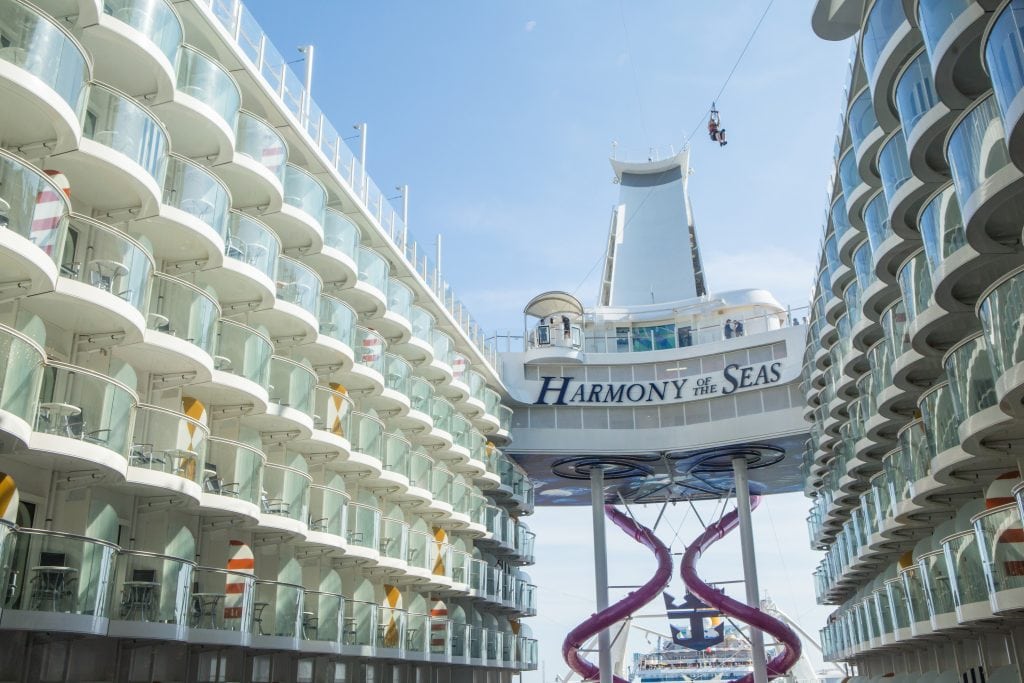Royal Caribbean Thinks It Has the Secret to Getting Newcomers on Board

Photo Credit: Royal Caribbean International's Harmony of the Seas is shown in Barcelona. The cruise line's parent company released positive third-quarter earnings Friday. Royal Caribbean International
Skift Take
Royal Caribbean reported a lot of promising news Friday, and investors were glad to hear it. Is it too soon to think the worst of this year's cruise woes are in the past?
Even as some promising markets continue to develop — or await an initial move — Royal Caribbean Cruises has taken more than 1.6 million passengers on their first-ever voyage this year.
The new-to-cruise market is key for operators, but they rarely disclose specific numbers. In a call to discuss third-quarter earnings with analysts, chairman and CEO Richard Fain revealed the figure as he spoke about the potential to grow the audience for cruising.
"That demonstrates our continued strength in this market and positions us for what we believe to be a bright future," Fain said.
The quarter was bright enough for Royal Caribbean, which owns and operates Royal Caribbean International, Celebrity Cruises, and Azamara Club Cruises. The Miami-based company also has an interest in several smaller European brands.
Net income was $693 million, and revenue increased to nearly $2.6 billion. Adjusted earnings per share of $3.20 beat Wall Street forecasts, though revenue came in lower than expected. Shares closed at $74.47, up more than nine percent.
Michael Bayley, president and CEO of Royal Caribbean International, called 2016 a "very productive year" with new cruisers, and said that while that number had been slightly on the decline in the past, the trend had turned around. Last year, the company carried 5.4 million cruisers total.
"We feel quite encouraged about what we are seeing," he said. Campaigns run both by Royal Caribbean International and Celebrity Cruises have focused on travelers who have not cruised before, though Bayley said the first-time cruisers have come disproportionately from new markets around the globe.
China, where Royal Caribbean has been focusing much of its global expansion, has struggled this year to maintain historically high pricing as capacity increases in the market. But executives said trends there look "encouraging" into the beginning of 2017, especially as industry growth is expected to reach only about 10 percent in Shanghai, where the bulk of ships are concentrated.
"It's actually a relatively slow growth year in relation to the past years, which is probably a good thing," Bayley said. Royal Caribbean's own capacity is flat to slightly down because the company is selling one of its older ships that sails in the market.
When an analyst asked what efficiency measures the operator could take to improve profitability if pricing was flat, Bayley said that efficiency isn't really the point right now.
"At the moment, our focus is developing the market and investing in the market — we believe the opportunity is significant in the future," he said. "We're not actively looking at efficiencies at the moment."
Europe, which has been a drag for most of 2016 due to North American passengers' reluctance to travel overseas after multiple terror attacks, appears to be picking up steam for next year. The company is reducing capacity in Europe, and the Eastern Mediterranean is still struggling. But other areas are coming back to life as travelers move forward with plans they might have postponed this year.
One nearby disappointment for Royal Caribbean was Cuba, which the company hoped to be visiting by the end of the year with a small renovated ship, Empress of the Seas. Yields, or revenues per berth per day, came in lower than expected because the cruise line held off on selling Empress voyages while awaiting word on whether it could enter Cuba.
While rival Carnival Corp. has been sailing Cuban itineraries since earlier this year with its new brand Fathom, Royal Caribbean Cruises is "still waiting patiently on Cuban government approvals," a spokesperson told Skift in an email.
Without directly mentioning Cuba, chief financial officer Jason Liberty told analysts that the operator would normally open up bookings 12 to 18 months in advance of sailing, but waited much longer. Empress is sailing short Bahamas and Key West cruises from Miami now.
"We had obviously been in conversations about what the future deployment of that ship could be, and that did not resolve itself in the back half of this year," he said. "We continue to look for that ship to have some other deployment... We'll deal with it as maybe some of that new deployment comes available."
